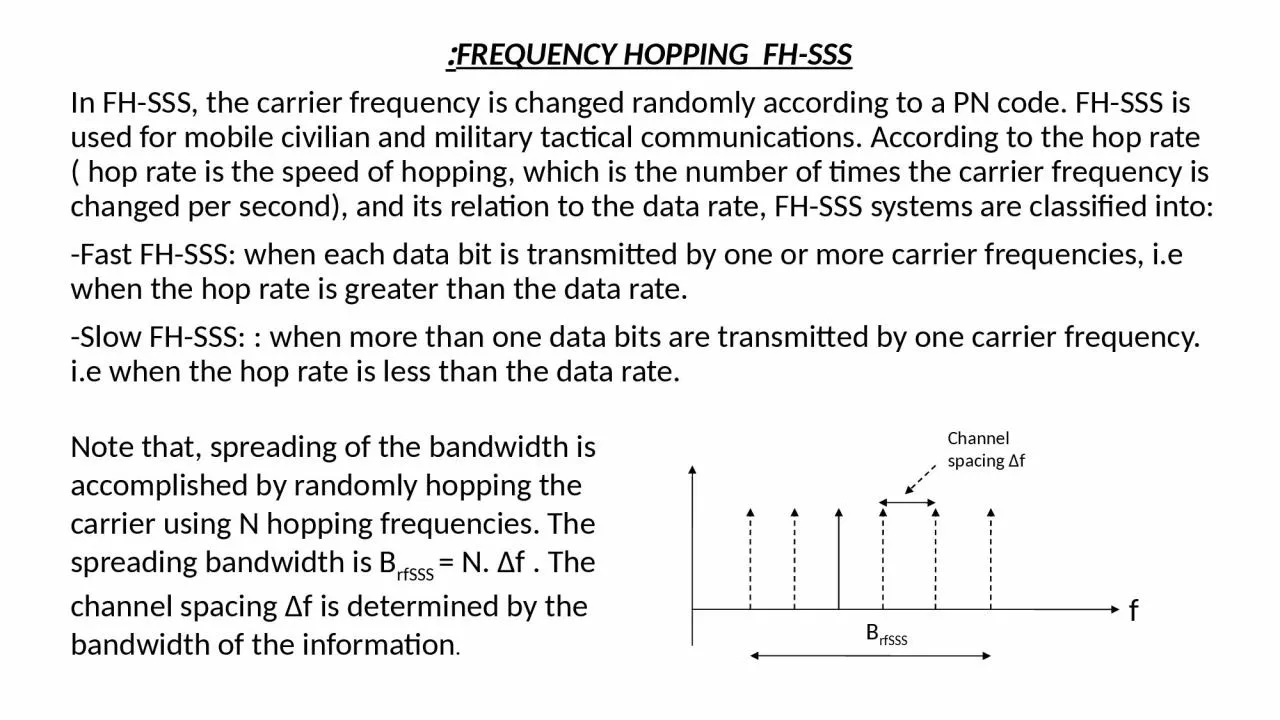

In FHSSS the carrier frequency is changed randomly according to a PN code FHSSS is used for mobile civilian and military tactical communications According to the hop rate hop rate is the speed of hopping which is the number of times the carrier frequency is changed per second and its relat ID: 1031000
Download Presentation The PPT/PDF document "FREQUENCY HOPPING FH-SSS:" is the property of its rightful owner. Permission is granted to download and print the materials on this web site for personal, non-commercial use only, and to display it on your personal computer provided you do not modify the materials and that you retain all copyright notices contained in the materials. By downloading content from our website, you accept the terms of this agreement.
1. FREQUENCY HOPPING FH-SSS:In FH-SSS, the carrier frequency is changed randomly according to a PN code. FH-SSS is used for mobile civilian and military tactical communications. According to the hop rate ( hop rate is the speed of hopping, which is the number of times the carrier frequency is changed per second), and its relation to the data rate, FH-SSS systems are classified into: -Fast FH-SSS: when each data bit is transmitted by one or more carrier frequencies, i.e when the hop rate is greater than the data rate.-Slow FH-SSS: : when more than one data bits are transmitted by one carrier frequency. i.e when the hop rate is less than the data rate. fChannel spacing ∆fBrfSSSNote that, spreading of the bandwidth is accomplished by randomly hopping the carrier using N hopping frequencies. The spreading bandwidth is BrfSSS = N. ∆f . The channel spacing ∆f is determined by the bandwidth of the information.
2. According to the modulation of carrier by data and address code, the following FH systems are given: 1-FH-SSS with conventional modulation: Here, the frequency hopper is controlled by a PN code, while the data signal (may be analog or digital) modulates the hopping carrier.fo = m . fr, where m is the random address set by the k-bit PN code generator 2k > m > 0At the Tx side, the PN code generator is driven by a clock that determines the hop rate. The k-bit parallel outputs of the PN generator are used to control the instantaneous carrier frequency fo.frfoAnalog informationdataK bit
3. The reference frequency fr is obtained from a high stable crystal oscillator. This fo is then used in any conventional modulator (may be analog or digital) to produce the FH signal.At the Rx side, there is an identical PN generator controlling the frequency synthesizer. The local frequency flocal hops synchronously with that at the Tx with a constant IF frequency between them, i.e: flocalK bitinformation
4. fIF= fo - flocal (note: both fo and flocal hops randomly but the difference between them is kept constant as the IF frequency) .Note: Suggested Seminar (report)on Frequency Synthesizers(types, operations,..etc):2-FH system with single channel data modulation:First, the carrier is modulated by a digital information signal and then the modulated carrier hops according to the PN code by a mixer & frequency synthesizer ( up conversion to fo), i.e, the data is first modulated then hopped.data mixer fo fc
5. Hopping pattern f2 f4 f3 f6 f1 f5 Th 2Th 3Th 4Th 5Th 6Th f f f1 f2 f3 f4 f5 f6Hopping patternhopping clock 1 2 3 4 5 6 f2 f4 f3 f6 f1 f5
6. If synchronization is achieved between the Tx and Rx PN generators, then the mixer output set at a certain fIF = fo-flocal is applied to the IF amplifier with a bandwidth equals the bandwidth of the PSK signal.datamixer